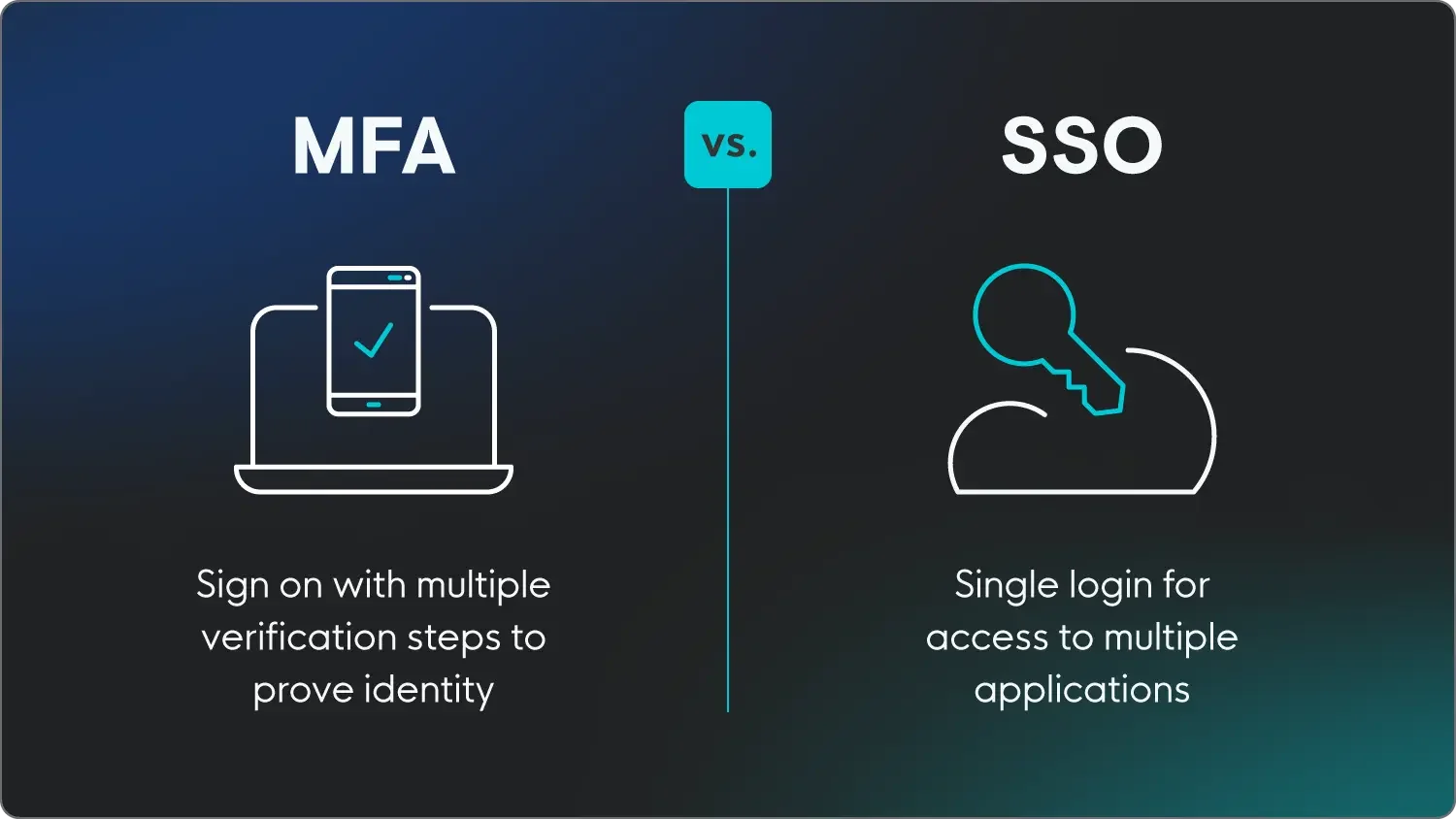






Usernames and passwords are the foundation of almost every application we use and every network we access. But these conventional credentials, first introduced more than 60 years ago by researchers at MIT in 1961, have become shockingly inadequate. The days of only relying on a simple username and password for protection are long gone.
As threat actors have become more clever and resourceful, companies need a stronger, more resilient defense. Enter single sign-on (SSO) and multi-factor authentication (MFA), two fundamental layers of security that can bolster your cyber defense in a relatively easy way. So, how do you choose between SSO vs. MFA? It’s not one or the other—it’s both!
In this blog, we'll delve into the world of SSO vs. MFA, explore their individual benefits, and explain why combining them can be a game-changer for your security posture.
Single sign-on, or SSO, is when applications or websites allow a person to log in using an already trusted third party to verify that the user is who they say they are.
Instead of juggling multiple usernames and passwords for different systems, users log in once, and SSO securely handles their access to various resources. You’ve probably seen or used this before as most websites today offer the option to log in with Google or Apple or Microsoft or Facebook or… you get the idea.
Multi-factor authentication, or MFA for short, is an authentication method that requires users to provide two or more verification factors before they can get access. These factors typically fall into one of three categories:
MFA brings a major security enhancement by adding an additional layer of authentication beyond just a username and password. Even if threat actors manage to steal login credentials, they can’t access the account without the second factor.

While both multi-factor authentication and single sign-on are part of the account login process, they have separate and distinct functions. Multi-factor authentication’s main job is proving the user is who they say they are, whereas single sign-on is designed to make logging in to multiple accounts easier.
Here’s an overview of the key differences between MFA and SSO.
|
MFA |
SSO | |
|
Main goal |
Security, reduces the risk of unauthorized access |
Convenience, reduces login fatigue |
|
User experience |
Extra steps added to verify identity |
Single login for multiple apps |
|
Complexity |
Layered authentication, requires more setup |
Integrates apps into one login system |
|
Typical use case |
Protecting the SSO identity |
Brokering access to enterprise and cloud applications |
|
Potential advantages |
Enhanced security, mitigates credential theft, and ensures compliance |
Convenient, reduces potential user fatigue, saves time, cost-effective, centralized control, improved security |
|
Potential disadvantages |
Users may find it inconvenient/fatiguing, SMS codes can be vulnerable, potential implementation challenges |
Single point of failure, reliant on identity provider (IdP) |
While SSO and MFA serve different purposes, combining them gives you a robust defense against cyber threats. Implementing both lets organizations improve their security without creating a bad user experience, while also making it easier to monitor network activity.
Let’s face it: Passwords are a vulnerability. It’s tough for people to remember the complex, multi-character passwords that almost every application requires today. So wouldn’t it be so much easier to remember just one? One solid, complex, and hard-to-guess passphrase, that is.
With SSO, that one passphrase is all a user has to remember. But of course, SSO means fewer potential entry points for hackers—and once they’ve cracked the code, the doors have opened to all the user’s other accounts and applications. This is why using strong, uncommon passwords and requiring an additional authentication layer with MFA is so important.
By combining SSO and MFA, you strike a balance between convenience and security. Users enjoy the simplicity of logging in once, while MFA adds an extra layer of protection: even if their credentials are compromised, an attacker still can't access their account.
Strengthening your security posture with SSO and MFA isn’t just a smart choice; it's a basic and essential step. To protect your employees and your organization, we highly recommend implementing both SSO and MFA.
When combined, SSO can help limit employee frustration and increase password strength, while MFA allows for verification of user identity before they log in to any application or network you want to maintain tight control over.
Here are some essential tips for successfully implementing MFA and SSO in your organization:
Cybersecurity is a challenge for IT departments across all industries. Not only are expectations getting higher, but the workforce is also evolving with new technologies and an ever-expanding global ecosystem. That means the risks are high as well.
Single sign-on and multi-factor authentication represent two fundamental layers of security that can work in tandem to combat the vulnerabilities of traditional authentication methods. By choosing SSO and MFA, rather than SSO vs. MFA, you have a bit more peace of mind while protecting your organization or managed environments.
At Huntress, we’re hyper-aware of how hackers are getting smarter and evolving their tradecraft. We need to implement changes to make it that much harder for attackers to access an application or network. That’s why the Huntress platform is enabled for both multi-factor authentication and two-factor authentication (2FA).
Huntress empowers your employees to be part of the cybersecurity solution with security awareness training (SAT), giving you personalized phishing defense coaching based on real threats our security experts see in the wild.
SSO stands for single sign-on, which means logging into one account to gain access to multiple services, like your Google account. MFA, or multi-factor authentication, is an identity verification process in which users are required to confirm their identity after logging in with something like a biometric scan or typing in a received code.
Yes, absolutely. In fact, it’s encouraged to implement both MFA and SSO to provide users with the best and most secure experience.
Two-factor authentication is a type of multi-factor authentication where two kinds of identity verification are required. MFA refers to when at least two types of verification are required, but sometimes more.
Get insider access to Huntress tradecraft, killer events, and the freshest blog updates.
